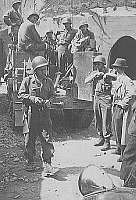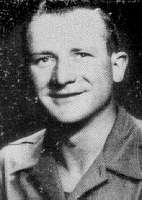Al Kosiek & Louis Haefliger
Both men have to be mentioned in connection with the liberation of the KZ Mauthausen and KZ Gusen Concentration Camps because both risked their lives and careers for the liberation of some 40.000 inmates in four concentration camps of the KZ Mauthausen-Gusen I, II & III Complex on May 5, 1945.
Louis Haefliger
A bank-clerk from Zurich, Switzerland. He volunteered in 1945 to guide a convoy of 19 trucks of the International Red Cross Comittee with food to the KZ Mauthausen Camps. When Haefliger arrived a few days prior to the liberation at KZ Mauthausen Camp on April 28, 1945 the commander of that camp, SS-Standartenfuehrer Ziereis, disallowed him to distribute that food to the prisoners. But Haefliger did not give up. He went back to nearby St.Georgen/Gusen and asked Ziereis to contact Ernst Kaltenbrunner.

At St.Georgen/Gusen, Haefliger learnt from local people about the crimes and real situation in the Mauthausen and Gusen concentration camps. He became committed to do more for the inmates than just bring the food-stuff. By the time Haefliger returned to Camp Mauthausen on April 30, 1945, and Ziereis had contacted Kaltenbrunner, Haefliger was offered accomodation with SS-OStuf Reimer, the chief of the KZ Mauthausen counter intelligence.
Since this high-ranking SS-man was also a bank-clark in civil life, he and Haefliger had a good rapport and therefore Reimer told Haefliger on May 2, 1945 about the secret plans of mass-extermination by blowing up the inmates and the local population in the KZ Gusen I & II underground installations. Hearing these secret plans of Pohl and Himmler to be carried out in the last days of the KZ Mauthausen-Gusen camp history, Haefliger decided to do all he could to prevent this tragedy. He overstepped the bounds of his duties as a Red Cross official and started to influence the war-scenario actively by bringing in Allied troops as soon as possible to the two concentration camps.
On May 4, 1945, with the help of Reimer, he painted one SS-car white so at to appear to be a Red Cross vehicle and organized a Red Cross flag. So, Haefliger, Reimer, and one driver started in the early morning of May 5, 1945 to search for Allied troops in the surroundings. With the help of Mr. Aschenbrenner, the vice-mayor of neighbouring St. Georgen/Gusen they reached the valley of the “Gusen” river north of St.Georgen where they saw the platoon of S/Sgt. Albert J. Kosiek …
S/Sgt. Albert J. Kosiek
When Kosiek and his 23 men first saw that white Red Cross car with Haefliger and the white flag accompanied by an SS-man, they assumed it was an SS trap. But Haefliger was able to convince Kosiek to follow them to liberate the 40.000 inmates of KZ Mauthausen-Gusen Complex (some 25.000 at Gusen and some 12.000 at Mauthausen). And so, Kosiek overstepped the bounds of his duties as well and followed Haefliger to St.Georgen, Gusen and Mauthausen.

In fact all of them risked their lives by doing so. Haefliger and Reimer might have been shot by the US troops in any case and Al Kosiek and his 23 men might well have been shot by any SS troops in the surrounding area. But nearly all went O.K. on this day as you can read in the personal report of Al Kosiek.
At first they liberated some 12.000 inmates of Camp Mauthausen without any fighting and some 25.000 inmates at the KZ Gusen I & II Camps later on.
While the liberation of Mauthausen was a peaceful one, the liberation of the KZ Gusen Camps was not as successful. At Camp Mauthausen an internal prisoners committee took over power after liberation. But not so at the KZ Gusen camps. Here, a very brutal excess of lynchings broke out between the inmates and some 500 of them were killed at the day of liberation by other inmates.
There had been many very brutal Kapos at the KZ Gusen without any future prospects and therefore heavy fighting broke out. Some of these Kapos hid themselves in the surroundings of the KZ Gusen camps and terrorized the local population for several weeks after the liberation. It took the U.S. troops several weeks to capture some 150 of them to bring them back to the KZ Gusen I camp at the end of May 1945.
Furthermore the conditions were so bad in the KZ Gusen II camp that some 2000 inmates died in the weeks after liberation (Father Jacques is just one example).
Recommended literature:
- Comitee International de la Croix Rouge, Die Tätigkeit des IKRK zugunsten der in deutschen Konzentrationslagern inhaftierten Zivilpersonen (1939-1946), Genf 1985
- Matt Alphons, Einer aus dem Dunkel – Die Befreiung … , Zürich 1988
#RememberGusen